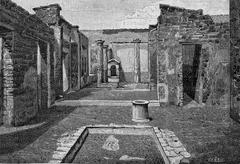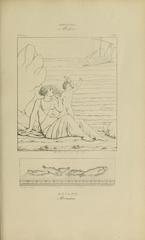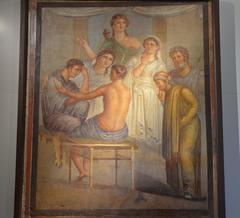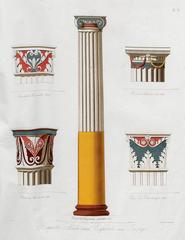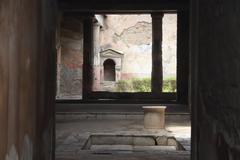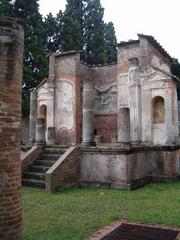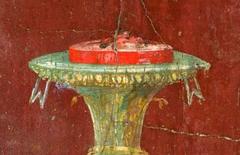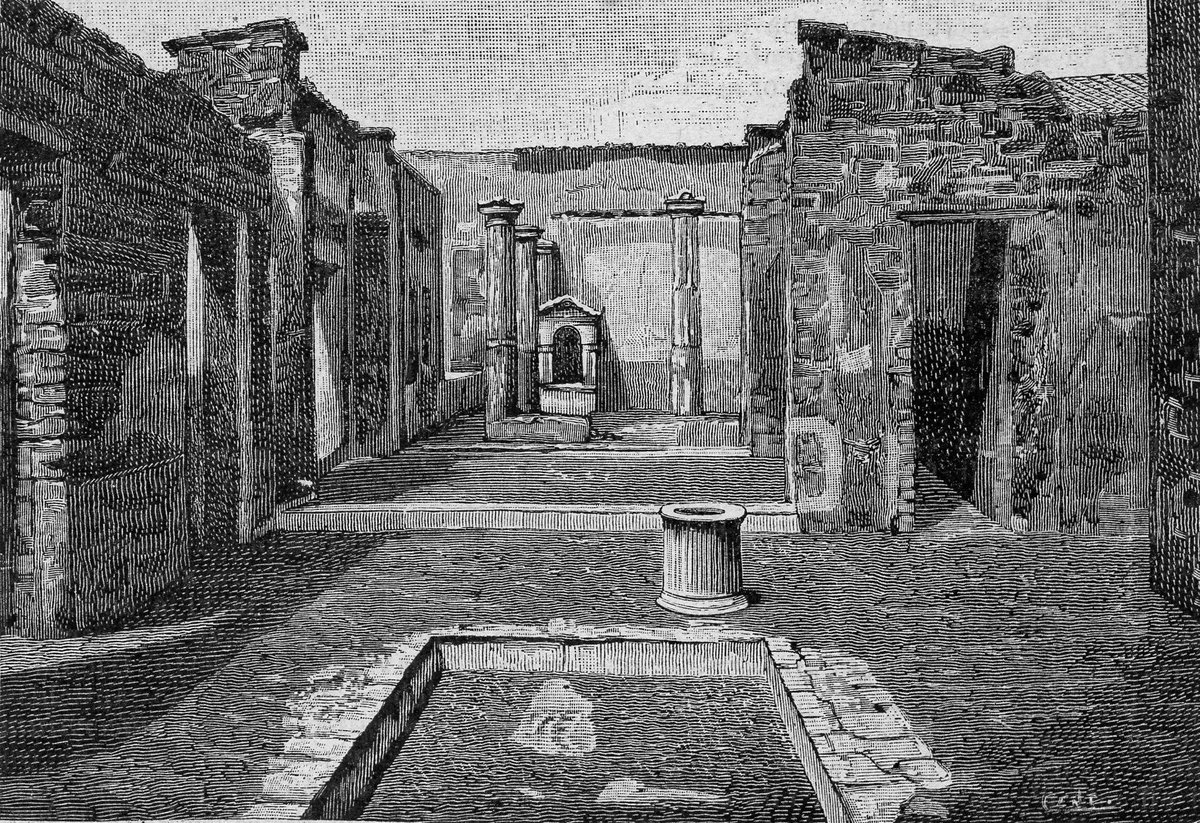
Visiting Hours, Tickets, and Tips for Scavi Archeologici di Pompei in Trecase, Italy
Date: 01/08/2024
Introduction
Discovering the Scavi Archeologici di Pompei in Trecase, Italy, offers a unique glimpse into the daily life of an ancient Roman city frozen in time by the catastrophic eruption of Mount Vesuvius in 79 AD. This archaeological site, a UNESCO World Heritage Site, is one of the most remarkably preserved ancient cities in the world, providing invaluable insights into Roman architecture, urban planning, and social life (Britannica). The history of Pompeii’s excavations stretches back to 1748, with early efforts driven more by treasure hunting than scientific inquiry. However, over the centuries, archaeological approaches have evolved significantly, with a focus on meticulous documentation and preservation (Smithsonian Magazine).
Visitors to Pompeii can explore a variety of well-preserved structures, including grand public buildings, lavish villas, and modest homes, each offering a window into the past. The site is not only a testament to the ingenuity of ancient Romans but also a symbol of the enduring efforts to preserve and understand our shared history. Whether you are a history enthusiast, a casual tourist, or a scholar, Pompeii offers an unforgettable journey back in time (Nomadic Matt). In this comprehensive guide, we will cover everything you need to know about visiting Pompeii, including its history, visiting hours, ticketing, travel tips, and more.
Table of Contents
- Introduction
- History of Pompeii
- Preservation Efforts and Challenges
- Technological Innovations in Archaeology
- The Role of Public Engagement
- Future Prospects
- Visitor Experience
- Practical Information
- FAQ
- Conclusion
History of Pompeii
Early Discoveries and Initial Excavations
The archaeological excavations at Pompeii date back to 1748 under the reign of Charles III of Spain. The initial excavations were rudimentary and often destructive, driven by the desire to uncover treasures rather than to understand the historical context of the site. Early efforts were characterized by a lack of systematic methodology, with many artifacts being removed without proper documentation (Wikipedia).
The Bourbon Period
During the Bourbon period, the excavations were controlled by the royal court, and it was even forbidden to take notes or make drawings without special authorization. This period saw the discovery of significant structures such as the Amphitheatre and the House of the Faun. However, the focus remained on retrieving valuable items rather than preserving the site (Made in Pompei).
19th Century Advances
The 19th century marked a shift towards more scientific approaches in archaeology. Giuseppe Fiorelli, who took charge of the excavations in 1860, introduced systematic methods and meticulous documentation. Fiorelli’s most notable contribution was the development of the plaster cast technique, which involved pouring plaster into the voids left by decomposed bodies in the ash layers. This technique provided a hauntingly detailed look at the final moments of Pompeii’s inhabitants (Smithsonian Magazine).
20th Century and Modern Excavations
The 20th century saw extensive excavations and the discovery of numerous buildings, frescoes, and artifacts. However, the focus gradually shifted towards conservation and preservation due to the realization that the site was deteriorating. The Great Pompeii Project, launched in 2012 with a budget of €105 million, aimed to stabilize and restore the site. This project has led to the discovery of new areas and artifacts, including vibrant frescoes and mosaics (World History Encyclopedia).
Recent Discoveries and Ongoing Research
Recent excavations have continued to yield significant findings. In 2018, a new area in Regio V was uncovered, revealing a wealth of artifacts and structures. Among the discoveries were a snack bar with colorful decorations, intricate mosaics, and graffiti that suggested a later date for the eruption of Mount Vesuvius than previously thought. These findings have prompted scholars to reconsider historical timelines and have added depth to our understanding of daily life in ancient Pompeii (Archaeology Magazine).
Preservation Efforts and Challenges
Preservation of Pompeii remains a significant challenge due to environmental factors and the sheer volume of visitors. In 1997, Pompeii, along with Herculaneum and Oplontis, was designated a UNESCO World Heritage Site to help protect its integrity. Despite these efforts, parts of the site remain vulnerable to decay and collapse. Conservationists continue to work on stabilizing structures and preventing further deterioration (Britannica).
Technological Innovations in Archaeology
The use of modern technology has revolutionized the study and preservation of Pompeii. Techniques such as 3D scanning, ground-penetrating radar, and digital mapping have allowed archaeologists to explore and document the site with unprecedented accuracy. These technologies have also facilitated virtual reconstructions, providing the public with immersive experiences of ancient Pompeii (Smithsonian Magazine).
The Role of Public Engagement
Public engagement has become a crucial aspect of Pompeii’s preservation. The Parco Archeologico di Pompei has embraced digital platforms to share real-time updates on excavations and research. The E-Journal of Pompeii Excavations, launched in 2023, provides detailed reports and findings, fostering transparency and public interest in the site’s ongoing discoveries (Made in Pompei).
Future Prospects
Looking ahead, the focus will likely remain on balancing excavation with preservation. Scholars like Mary Beard advocate for leaving parts of the site unexcavated to protect them for future generations. Meanwhile, ongoing research and conservation efforts aim to ensure that Pompeii continues to offer invaluable insights into ancient Roman life while remaining accessible to the public (Smithsonian Magazine).
Visitor Experience
For visitors, Pompeii offers a unique opportunity to walk through a city frozen in time. Key attractions include the Forum, the Amphitheatre, the House of the Faun, and the Villa of the Mysteries. The site is open year-round, with varying hours depending on the season. To make the most of your visit, book tickets in advance and consider guided tours for deeper historical insights (Nomadic Matt).
Practical Information
Entrances
Pompeii is easily accessible from Naples, either by car or public transport. The site has multiple entrances, with Porta Marina being the busiest (Helen on Her Holidays).
Security
All visitors must go through airport-style security checks (Nomad Epicureans).
Guided Tours
Guided tours are recommended for a more insightful visit. Reputable companies like Take Walks offer comprehensive tours that include skip-the-line tickets (Nomadic Matt).
What to Wear
Comfortable walking shoes, sun protection, and water are essential, especially during summer (Leisure Italy).
Accessibility
Pompeii offers routes for disabled and blind visitors. Detailed information on accessible routes can be found on the See Pompeii website.
Special Programs and Events
House of the Day: This program allows visitors to explore a house that is not normally open to the public. The schedule for the House of the Day can be found on the Pompeii website.
Summer Events: During June and July, there are often theatrical and music performances in the Roman Teatro Grande or occasionally in the Amphitheatre (Helen on Her Holidays).
Nearby Attractions
Consider visiting nearby sites such as Herculaneum, Oplontis, and the Naples National Archaeological Museum. The Campania Artecard offers access to multiple sites, including Pompeii and Herculaneum, and can be a cost-effective option for tourists (Helen on Her Holidays).
Dining and Refreshments
There are limited dining options within the archaeological site, so it is advisable to bring snacks and water. There are cafes and restaurants near the entrances where you can enjoy a meal before or after your visit.
Safety and Behavior
Visitors are expected to display good and acceptable behavior while exploring the site. This includes not touching the ruins, staying on designated paths, and not littering. For a safe visit, follow the guidelines provided by the site authorities (Pompeiisites.org).
Photography
Photography is allowed, but the use of tripods and flash is generally prohibited to protect the delicate frescoes and artifacts. Always check for specific rules regarding photography in certain areas of the site.
Time Allocation
Pompeii is a sprawling site, and a thorough visit can take anywhere from 4 to 6 hours. If you are short on time, focus on the main attractions such as the Forum, the House of the Vettii, and the Villa of the Mysteries (The Geographical Cure).
Weather Considerations
The weather in Pompeii can be quite hot during the summer months. Plan your visit during the cooler parts of the day, and stay hydrated. Spring and fall are ideal times to visit, offering pleasant weather and fewer crowds (Helen on Her Holidays).
FAQ
-
What are the visiting hours for Pompeii?
Pompeii is open year-round, with varying hours depending on the season. It is advisable to check the official website for the most up-to-date information. -
How can I buy tickets for Pompeii?
Tickets can be purchased online in advance or at the entrance. Booking in advance is recommended, especially during peak tourist season. -
What are the best times to visit Pompeii?
The best times to visit are early morning or late afternoon to avoid the midday heat and crowds. Spring and autumn are ideal seasons for a visit.
Conclusion
The history of Pompeii’s excavations is a testament to the evolving nature of archaeology and the enduring fascination with this ancient city. From early treasure hunts to modern scientific methods, each phase of excavation has contributed to our understanding of Pompeii. As preservation efforts continue, Pompeii remains a vital link to the past, offering insights into the daily lives, art, and culture of ancient Rome. By visiting Pompeii, you are not only witnessing history but also contributing to its preservation for the future (Smithsonian Magazine).
For further insights and travel tips, be sure to check out additional resources and stay connected through our mobile app Audiala and social media channels.
